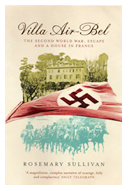
A TRAVELER IN MEXICO:
A RENDEZVOUS WITH WRITER ROSEMARY SULLIVAN
C.M. MAYO
Originally published in Inside Mexico, March 2009
Mexico City’s Coyoacán neighborhood has become inextricably linked with the Surrealist painter Frida Kahlo, so what better place to rendezvous with poet, writer, and biographer of Surrealists, Rosemary Sullivan? A professor of English at the University of Toronto, Sullivan had just alighted in Mexico City and would soon be on her way to meet with Surrealist painter Leonora Carrington, when we met over cappuccinos at the sun-drenched Café Moheli to talk about her latest book.

Villa Air-Bel: World War II, Escape, and a House in Marseille is a page-turner of a deeply researched history about the rescue of artists and intellectuals trapped as the Nazis closed in. The effort, fomented by the New York-based Emergency Rescue Committee and led by their agent in Marseilles, Varian Fry, managed to save André Breton, Marc Chagall, and Max Ernst, among others, and found refuge for them in the United States. But some came to Mexico. These included the Russian novelist Victor Serge, and his son Vlady; and most famously, Surrealist painters Leonora Carrington and Remedios Varo, who (along with Frida Kahlo), are today among Mexico’s most revered artists. For this reason, Villa Air-Bel is a work important to the history of modern art in Mexico.
But the book’s connection to Mexico goes deeper.
“Villa Air-Bel started here,” Sullivan said. She explained that, back in 1995, she had come to Mexico City to write about the intense friendship of three women artists Leonora Carrington, Remedios Varo, and the Canadian poet P.K. Page (also known as the painter Pat Irwin), which commenced in 1960 when Page, already the author of several books and a winner of Canada’s prestigious Governor General’s Award, arrived with her husband, Arthur Irwin, then Canada’s ambassador to Mexico.
Sullivan, then two years out of graduate school, met Page in Victoria in 1974. As Sullivan recalls in the essay “Three Travellers in Mexico,” “For me P.K. is one of the searchers, ahead of the rest of us, throwing back clues. She encouraged me to believe I might become a writer.” Varo had died of a heart attack in 1963. But thanks to an introduction from Page, Sullivan met Carrington in Mexico City.
The English-born Leonora Carrington had a harrowing but triumphant story. She was living in France when the Germans invaded. Her lover, the Surrealist painter Max Ernst, was arrested, first as an enemy alien and then a second time as an enemy of the Nazis. Leonora fled to Spain, where she had a mental collapse and was put in an insane asylum, a searing experience she wrote about in The House of Fear: Notes from Down Below. Her family got her out, but thinking they wanted to put her in another asylum in South Africa, she escaped in Lisbon en route. Ernst, miraculously, reappeared in Lisbon, but the pair parted ways, Ernst going to New York with Peggy Guggenheim, and Leonora, in a marriage of convenience to her rescuer, Mexican diplomat-poet Renato Leduc, to Mexico. Here she remarried, produced two sons, and an extraordinary body of work as a painter, sculptor, poet and writer. (Still active in her 90s, last month [February 2009] Carrington attended an event in her honor at Mexico City’s Museo José Luis Cuevas.)
In 1995, Carrington showed Sullivan some of Varo’s playfully dreamlike and delicately-rendered paintings. Later, while reading Unexpected Journeys, Janet A. Kaplan’s biography of Varo, Sullivan came upon the story of Varian Fry and the Villa Bel-Air, a château outside Marseille where so many of the outstanding figures involved either lived or visited. For a time, though they were in terrible danger and lacked such basics as coal and meat, with André Breton hosting a Sunday open house and leading Surrealist games in the drawing room, Villa Air-Bel had all the joyous spirit of an artists colony.
While in Mexico City that time, Sullivan also wrote the short story that became the nucleus of Labyrinth of Desire, an exploration of the myths women live out when they fall in love, from Rhett Butler and Scarlett O’Hara (“Don Juan / Doña Juana”), to Diego Rivera and Frida Kahlo (“Self-Portrait with Mirrors”). In that short story, Sullivan said, “The man is named Varian, but just because I loved the name. I never imagined I’d write this book! He just sat at the bottom of my mind…”
While reading The Quiet American, Andy Marino’s biography of Varian Fry, Sullivan saw the image that made her decide to write about the refugee artists and intellectuals and their rescuers. In the photo, like a pair of children, Fry and Consuelo de Saint Exupéry perch high in the python-like branches of an plane tree.
“This was war-time France!” Sullivan exclaimed. “What were they doing in the tree?” They were hanging paintings. “That refusal to be cowed by Fascism… “
But how to tell such a huge and sprawling story? In a flash, Sullivan realized that she could organize it around a year in the life of Villa Air-Bel.
Other than Carrington, however, few of those who had been at Villa Air-Bel were still alive.
One of the most important sources had to be Vlady Serge, the painter who, as a young man had been rescued from France along with his father. From Canada, Sullivan made an appointment for an interview in Cuernavaca, where he had his house and studio. She then flew to Mexico. She settled into Las Mañanitas hotel, and when she telephoned that she was on her way, she was informed he was not there. It turned out Serge had been rushed to the hospital with a fatal stroke. Sullivan had missed him by a matter of minutes; nonetheless, he had left her detailed instructions on whom to meet and where to find archives.
Here in Coyoacan’s Café Moheli, the snortle of the cappuccino machine interlaced with birdsong, conversations, and the occasional passing car, I said, what had most struck me about Villa Air-Bel was the way she described the confusion at the time, and how, throughout the 1930s, people had a sense of normalcy, until—I quoted her—”in a moment, the world collapsed like a burnt husk.”
“I meant people to read this book in terms of now,” Sullivan said. “Because it can always happen.”
I welcome your courteous comments which, should you feel so moved, you can email to me by simply clicking here.

From the B. Traven Conferences in Berlin / Plus Cyberflanerie
Carolyn E. Boyd’s The White Shaman Mural
My new book is Meteor

Find out more about
C.M. Mayo’s books, articles, podcasts, and more.

